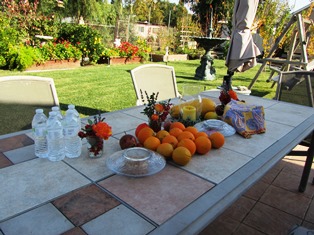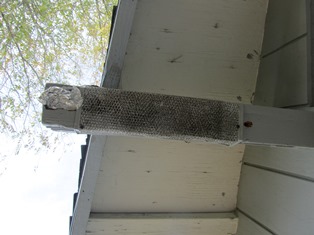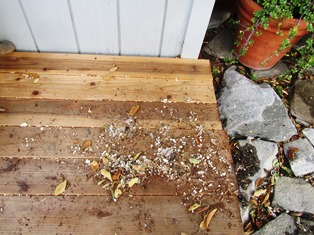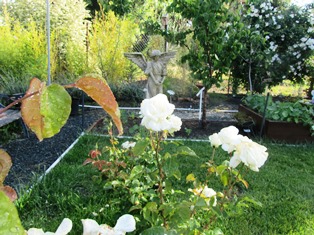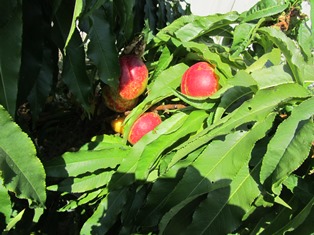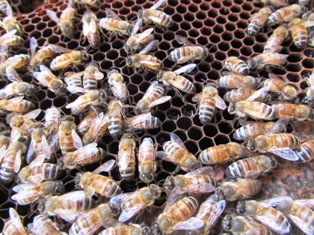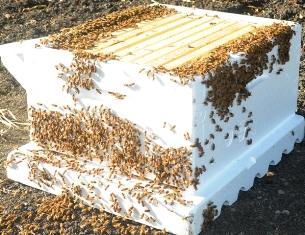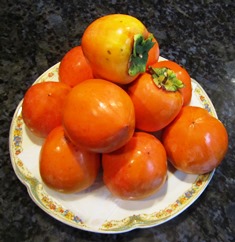Archive for November, 2013
A Roving Thanksgiving Starts with Snacks on the Farmette
The spontaneous invitation my husband made to friends to stop by for a Thanksgiving snack and beverage before the “real” meal started sent me scrambling. What was he thinking? We were celebrating with all the relatives at my daughter’s home, not ours, so how could I host a pre-party gathering? He assured me we could make it work if we kept it simple.
Our friends were scheduled to dine at a neighbor’s house in the late afternoon but decided they would come by our place first. I figured such a short visit of an hour or two wouldn’t require an elaborate meal . . . we would snack on crackers and goat cheese, drizzled in a sweet cranberry sauce; pumpkin cream cheese rolled in nuts; and a torte of goat cheese with a layer of pesto, sun-dried tomatoes, and finely chopped pieces of olive. We would offer bottled water, sparkling cider, and a wine to wash it down.
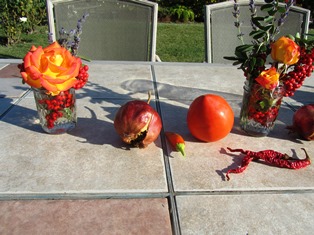
I gathered what was growing on the trees and in the garden to decorate an autumn harvest-looking table
Our Northern California weather could not have been lovelier, so I decided we would sit outside in our garden. I combined red pyracantha berries with blooming red-gold roses and some spikes of purple French lavender in jam jars for a harvest festival look on our patio table.
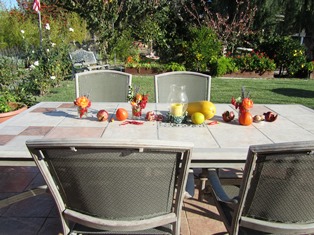
Decorations for the table began with a few pomegranates, persimmons, chilies, and onions–all readily available on the farmette
Our friends arrived and, after a short time in our tiny farmhouse, followed me to the garden. We had a lovely visit while the blue jays, crown sparrows, morning doves, and black phoebes entertained us with their antics. I think I enjoyed the day all the more for having a chance to socialize a bit in the garden before sitting down to the big feast with all the relatives. Next year, I might actually plan to do a roving Thanksgiving with several parties. It was so much fun!
The Woodpecker Saga Continues
The woodpecker is back and apparently intent on taking down our roof strut. As I’ve mentioned in a previous blog, I believe it is a Nuttall’s Woodpecker (Picoides nuttallii) and possibly a female because of its small size and lack of red color on the back of the head and nape of the neck. The bird was named for naturalist Thomas Nuttal in 1843. It doesn’t eat acorns, yet its habitat is California oak woodlands.
After making two holes large enough to all but obscure the creature pecking away inside the beam, the woodpecker took off after I shooed him away. But despite me screwing in a screen to cover the two gaping holes, the woodpecker has created two new holes and has made a heck of a mess.
My husband and I awoke to the rat-ta-tat-tating before daylight. After a quick inspection of the woodpecker’s drilling, Carlos told me to stick aluminum foil into the hole until he could return from work today and either saw off the dead wood and reinforce the beam or figure out another solution.
In the mess on the porch floor beneath the roof beam are what appear to be remnants of a nest. Is it possible that the woodpecker once constructed a nest inside that roof beam? They nest in tree cavities, so it isn’t too far of a stretch from a tree to a strut. This industrious female might be trying to create a nest for mating season (January to March), preparing for egg laying in April and May. And interestingly, the male incubates the eggs at night while the female sits on them during the day for a total of about 14 days.
While the woodpecker pecks, I’ve resigned myself to staying in the kitchen, baking our pumpkin and pecan pies for Thanksgiving. All the while, I hear the tapping of a drumbeat as the woodpecker either forages for food (it likes insects and spiders and some berries) or creates a cavity for a nest.
Fire Can Facilitate Germination of Redbud Tree Seeds
Seems strange that any plant seed could germinate by fire, but fire cracks the seed coat of the Western Redbud (Cercis occidentalis), permitting germination to occur. Redbud trees undergo rampant re-sprouting following a fire.
The Native Americans who favored the lovely red bark and straight new shoots of saplings for their basket weaving understood this. In fact, long before California was settled by European Americans, the Native American tradition was to selectively set fire to hillsides, canyon slopes, and dry river beds dotted with redbuds to stimulate a proliferation of new saplings.
Wondering how to germinate a redbud without fire, I conducted a little research and learned that if I poured boiling water over the seed (after removing it from the seed pod) and then allowing it to rest overnight before planting it in well-drained soil, it most likely would germinate. Once germinated, the young tree is relatively easy to grow. See http://plants.usda.gov/plantguide/pdf/cs_ceor9.pdf
It just so happens that behind the Henny Penny Farmette, a neighbor has several redbud trees that have dropped many pods in the last month or so. Last year, I tried transplanting a sprout or two without success. This winter, I’ll start from seed, but I think I’ll go the boiling water route to germination.
These trees are a sight to behold when they are in full bloom, around mid-March. The Western Redbud is also known as the California Redbud. There is an Eastern variety as well.
Oats–Farm Cooking Staple Lowers Cholesterol
Steel-cut (Irish) and stone-ground (Scottish) oatmeal has a place on my pantry shelf alongside a container of quick oats. Steel cut means the groats (oat grains) get cut by a steel blade after they have been hulled. The groats of stone-ground oats are cut even smaller than the steel-cut and ground. See http://wholegrainscouncil.org/whole-grains-101/types-of-oats
In rolled oats, the groats are further flattened into flakes. But whether you eat steel-cut oatmeal that takes up to a half hour or more to cook or rolled oats that cook in minutes, you can take comfort in the fact that you are doing something good for your body.
Studies have shown that oatmeal can lower cholesterol, and lower cholesterol reduces the risk of heart disease. Steel-cut oats taste about the same as quick oats and nutritionally, the two two are also similar. See http://www.mayoclinic.com/health/cholesterol/CL00002e
Growing up n a farm, oatmeal made its way to our table on a regular basis. The women in our family also used oatmeal to create sweet treats–cookies and old fashioned deserts. Their crumbles, crisps, and betties incorporated oats in a pastry type topping laid over fruit and baked.
A crumble topping that adds oatmeal and nuts to the flour is known interchangeably as crumble or crisp. Betty is the name applied if the fruit used is an apple variety prepared with sugar, spices, and bread crumbs. The term dates to Colonial America. Sugar sweetens the crumble and butter makes it hang together in a pastry with a crumbly texture.
Here’s an example of how oatmeal might be used in a fruit crumble, crisp, or betty recipe. After sprinkling the topping onto the fruit, the dessert is baked at 375 degrees Fahrenheit for 30-35 minutes.
Ingredients for fruit filling:
6 cups cherries, apples, pears, mixed berries, or other fruit
1 cup sugar (or more, if the fruit is very tart)
1 teaspoon lemon juice (keeps the fruit from turning brown)
1 teaspoon cornstarch (use more if the fruit is very juicy and requires a thickening agent)
1 teaspoon spice such as nutmeg, ginger, or cinnamon, depending on the fruit used
Directions:
Mix fruit and ingredients together and pour into a baking dish.
Ingredients for the crumble/crisp topping:
1 cup flour
1/2 cup oats (optional)
1/2 cup chopped nuts (optional)
1/2 cup brown sugar
1/2 teaspoon baking powder
1/4 teaspoon salt
1/4 teaspoon spice (like cinnamon or ginger, depending on the type of fruit used)
1/2 cup butter (8 Tablespoons)
Directions:
Mix together the dry ingredients and cut in the butter until crumbly. Sprinkle on top of the fruit and bake for 30-35 minutes.
Drastic Measures to Keep the Woodpecker Away
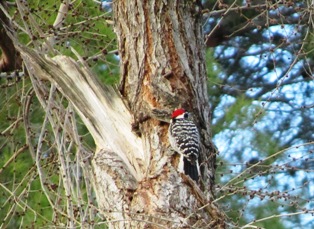
This lovely Nuttall’s Woodpecker has returned this year, perhaps to watch its offspring peck away at our roof strut
It’s been a week of rat-ta-tat-tat-tating and I’m growing wearing of hearing it. The woodpecker’s sound ordinarily doesn’t bother me, except I know it is pecking the foam, widening the hole of an exterior beam supporting the roof of this old house.
While my husband is away visiting relatives and I’m trying to keep the place tidy, the woodpecker isn’t going along with the plan. It is making a mess on the porch that rivals the squirrels’ messes when nuts are in season.
The bird has pecked wood shavings that fall into a pile on the porch. Worse, it is also pecking out the dry foam that we sprayed into the holes. Stopping the woodpecker’s assault against our beam forced me to take drastic measures.
When I heard the pecking this morning, I circled around the back of the house and sneaked along the side to catch the bird in the act. Seeing me, it took cover in the nearby elm tree.
From the bird’s size, I believe it to be either a female or a juvenile Nuttall’s woodpecker. We had one here last year that I photographed high in the pine tree. See http://www.allaboutbirds.org/guide/Nuttalls_Woodpecker/id
The solution, I think, might be a screen I found in a frame that clamps nicely over the two holes. Since securing the metal in place with screws, I haven’t heard a single rat-ta-tat-tat . . . not even in the nearby pine or the elm trees.
Fall Spraying for Peach Leaf Curl
Just beyond the sliding glass door of my kitchen, we’ve carved a bit of a lawn and garden out of a wild weedy field. When I’m washing dishes or making jam, I can see my garden sanctuary where I’ve moved in a statue of an angel and positioned a bench near two nectarine trees–a perfect place to sit and take in the view of Mount Diablo’s peaks.
Of late, though the nectarine trees look less than healthy. The two heavy-bearers have become infected with the fungus that causes peach leaf curl. It’s not just my trees that are infected; two of my neighbors have the same problem. And this showed up late in my trees this year.
I’ve tried plucking off the twisted and contorted leaves as they show, discarding them in the garbage (not the compost pile). However, I fear I am losing this battle. The trees are going through a leaf drop now that it’s middle of November. I don’t want that fungus overwintering in the infected leaves, so I’m gathering those into the garbage, too. And I’ll begin a spraying program.
The nectarines and peaches need to be sprayed three or four times (if we have a strong rainy season), from autumn to bud break in the spring. Both lime sulfur and copper sprays can be used; both are considered organic, although some formulations are not very strong. But the leaves must not remain on the ground under the trees.
Last year, I sprayed those trees the required number of times with an organic horticultural oil recommended by the local garden center. The trees were fine most of the summer. But last month, the infection showed up. And here I am now, plucking the leaves from the trees and picking them up from the ground.
I dare not use anything on treating the fungus that is not organic and safe for the honeybees. Come spring, perhaps I’ll be rewarded for my vigilance with new growth that is healthy and free of the fungus.
An Extra Blanket for the Bees
With Thanksgiving only a couple of weeks away, weather is turning downright frosty at night. I asked my beekeeper neighbor if it was time for us to throw some blankets over the hives to help the beleagured honeybees stay warm. We did this last year along with feeding the bees with a good result of thriving hives in the spring.
In the wintertime, the honeybees cluster toward the middle of the hive, their muscles responsible for flight now shivering (albeit in a different way than when taking flight), to generate heat. The colder it gets, the tighter the cluster and harder the bees have to work to stay warm. If the the core temperature of the hive drops too low, the colony will die. See http://indianapublicmedia.org/amomentofscience/honeybees-winter/
During winter months, proper ventilation to maintain a dry hive is a must. Since bees eat and metabolize honey to generate heat, carbon dioxide and water are produced. The carbon dioxide, heavier than air, descends and exits the bottom of the hive while the water vapor rises to the cold inner roof and drips back down as condensate on the poor bees. Freezing and starvation can cause bee die-offs in the winter.
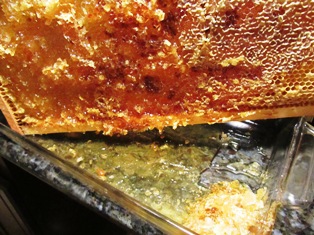
Bees eat and metabolize honey from stores within the hive during winter when outside food sources are scarce
We drape each hive with a blanket over the top and around the back and sides, but not in front where the openings are located. Bees need to be able to enter and exit. As soon as the temperatures warm, my neighbor and I pull back the blankets during the day.
Some might suggest that putting out an extra blanket for the bees is interfering with nature’s processes and survival of the fittest, but on the other hand, the colony has remained strong and healthy over this last year.
Human use of pesticides has wreaked untold harm on the population of these important pollinators. Isn’t it about time, we considered the plight of the bees and did something to help them survive, like planting excellent food sources for every season and giving them medicine when they need it an an extra blanket for warmth? See, http://www.mariasfarmcountrykitchen.com/help-honey-bees-survive-winter/
“Fruit of the Gods” Ready To Eat Now
If you love persimmons, it might interest you to know they are from a genus known by the Greeks as Diospyros kaki, “fruit of the gods.” But these sweet fruits must be fully ripened before consuming. The Fuju and Hachiya are the two main types grown in Northern California gardens. My favorite is the Hachiya; it has to be one of the most sensuous and luscious fruits on the planet to eat.
The Fuju fruit is more like an apple in shape and texture. You can differentiate it from the Hachiya because Fuju is squat and firm-fleshed, reddish yellow, and about the size of a baseball whereas the Hachiya fruit is pendulous-shaped, soft like an overripe plum, orange-scarlet in color, and about the size of a hefty apple or softball. Tamopan is a larger persimmon with a shape like a turban whereas Chocolate is so-named for its brown streaks; its flesh is quite sweet.
Persimmon trees look stunning in a garden, possessing outstanding ornamental qualities. They are relatively pest-free and produce consistently when mature. These small trees are easy to grow, have striking foliage and interesting branch structure, exposed after the leaves have fallen in autumn. They can even be espaliered against a frame or wall.
Hachiya persimmons are astringent on the tongue unless eaten when they are fully soft-ripe. Birds love them, too, so you have to pick them before they are pecked. Ripen in the kitchen before eating or cooking with them. If you want to dry persimmons, pick while the fruit is still firm and with some stem. Tie a string around the stem and hang in the sun until the fruit becomes dried. It will taste something like a high-quality prune or lichti.
Saving Seed for Future Generations
I spent the morning looking through Seed Savers Exchange’s online offerings. If you haven’t heard of the Seed Savers Exchange (SSE), the nonprofit organization based in Decorah, Iowa that works to preserve “our gardening heritage,” then I urge you to check it out. See http://www.seedsavers.org/About-Us/Mission/
What really got me excited was SSE’s “Slow Food U.S. Ark of Taste.” It’s a catalog listing over 200 foods in danger of becoming extinct, including varieties of beans, tomatoes, lettuces, squash, corn, and peppers.
I’m interested in growing some of the old varieties of heirloom beans, for example, the Turkey Craw bean, from Virginia, North Carolina, and Tennessee. The original bean seed was said to have been discovered in that part of the United States in a turkey’s craw.
I also want to plant the bean known as Jacob’s Cattle. Originally the Passamaquoddy Indians in Maine grew this bean. Apparently once New Englanders discovered its excellent taste, the bean became a favorite in their baked beans and chili dishes.
We live in an age when our culture’s emphasis is on fast and faster. But we’ve seen the consequences of fast food on our country’s obesity epidemic. When it comes to delicious, wholesome, and healthy, fast food may not be so good for us and our children.
The seeds from Seed Savers Slow Food U.S. Ark deserve to be saved. What we save now can be passed to the next generation for safekeeping, ensuring, among other things, that Earth’s biodiversity is preserved for all generations. See, http://www.seedsavers.org/
Herbs to Flatter Vegetables, Flavor Meat, and Finesse Fertility

If you have limited space, use taller herbs like this lavender in your landscape and gr0w smaller plants like mint in pots
Herb gardens have always held a fascination for me. One of the many reasons I love growing herbs is the scent that many herbs release with bruising that can occur when you brush against plants such as bee balm, rosemary, or lavender.
Most herbs contain fragrant oils (verbena and lavender, for example) that are frequently used in the making of cosmetics. Many herbs reseed themselves, ensuring a perennial supply for medicinal and culinary uses.
For thousands of years, herbs have been added to food to enhance the flavors. In fact, many cuisines of the world are distinctly identifiable from herbs and mixtures of them added to the food. Imagine Italian marinara without the addition of basil in the tomato sauce; a French meat or vegetable dish without savory, fennel, sorrel, rosemary, or tarragon; or an English traditional dish without bay leaf, marjoram, garlic, or mint. Consider Greek food without rosemary, thyme, or arugula.
Herbs have been used to flavor vinegar, olive oil, and liqueur. Herbs even play a role in amorous arousal. In France, Verveine du Velay is a vervain-flavored liquer popular in Le Puy. It’s reputation is further enhanced by the popular ages-old perception of it as an aphrodisiac. According to author Jade Britton (The Herbal Healing Bible, Chartwell Books, Inc.), the herbs Siberian ginseng, damiana, and saw palmetto have been used in remedies to treat male infertility along with gingko for increased blood supply to the male sex organ. See, http://www.amazon.com/The-Herbal-Healing-Bible-Traditional/dp/0785829652
While many herbs thrive in well-drained, sunny positions in the garden, others do equally well in part sun/shade. For shade-tolerant herbs, plant the following.
Chives
Cilantro/Coriander
Garlic
Lovage
Lemon Balm
Mint
Oregano
Parsley
Sweet Woodruff
Thyme
You can grow herbs in a pot, a coffee can, a half wine barrel, window box, even an old wheel barrow. The point is that herbs are not too fussy. Some are so vigorous as to be considered invasive (mint, for example). So whether you seek the enhance the flavor of food, add pizazz to a meat dish, or to increase your stamina, libido, and overall health, maybe it’s time to plant your own herb garden and see what herbs can do for you.
 Facebook
Facebook Goodreads
Goodreads LinkedIn
LinkedIn Meera Lester
Meera Lester Twitter
Twitter




